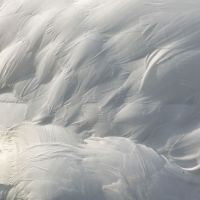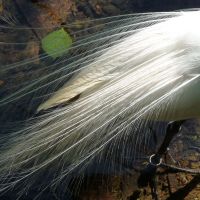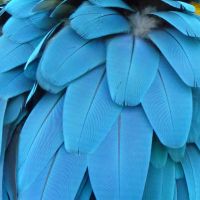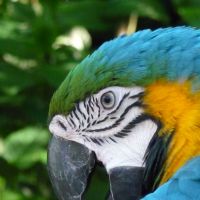A soft flake of seeming sky falls, wafts and floats earthward catching the light. Lightly, and soft as gossamer, it lands to add a splash of color to the greenery of spring. It may be no more than a tiny feather that's fallen from a passing bird, but it carries with it a message of mystery and miracle from the heavens.
Not all creatures that fly have feathers — witness bats, insects, even some reptiles, amphibians and fish. Flight is a challenge that many groups of organisms have risen to independently at different times during their evolutionary histories, whenever need or advantage arose.
Plants too, though physically rooted to the Earth for most of their lives, have — in their winged airborne seeds and aeolian pollen — a life-stage that includes flight. Ferns and fungi releasing billions of airborne spores can also be said to rely on flight, after a fashion.
Yet not all creatures that have feathers can fly — witness the emus, ostriches, rheas and penguins, and the many flightless species of birds inhabiting remote islands, such as the kiwi and weka of New Zealand and the Flightless Cormorant of the Galapagos. Then there's that icon of both flightlessness and extinction — the Dodo of Mauritius.
Feathers, however, more than nest-building or egg-laying, represent the single defining characteristic of one particular group of living life forms: birds.
By definition, if a creature has feathers, it is a bird; if it lacks feathers, it is not a bird. It is not just that birds have feathers, but that feathers form their bulk, weighing in at more than their skeleton. Feathers provide color and crypsis, insulation and air-conditioning, streamlining, buoyancy and waterproofing; they may signal gender and seasonality; and they are crucial for many species in the elaborate displays that conclude in reproduction. Then last but not least, a small proportion of them facilitate flight.
Given that feathers serve so many invaluable functions, it is hardly surprising that birds spend inordinate amounts of time each day in primping and preening to keep their feather coats in good condition.
Comprised of a light, strong protein known as keratin, akin to our own hair and nails, feathers come in many forms. All of them emerge from follicles in the skin, but these differ from our own hair follicles in that they are ringed by muscles under the control of the bird, allowing the animal to raise and lower its feathers, to adjust their angle, to spread them or compress them, to elevate and fluff them when temperatures fall, or to allow more air to pass over their skin when hot.
The vast majority of a bird's feathers are known as contour feathers, which typically number in the thousands; it is these that cover and conceal the form of the body. Only the few dozen wing and tail feathers constitute the flight feathers that provide the lift, and the power.
The symmetry of the contour feathers is characteristic. A short, somewhat stiffened rachis bisects the feather's soft vane, like a bamboo strip stiffens a paper fan, or a midrib divides the flat blade of a leaf. Unlike leaves, most contour feathers are not flattened, but curved — some of them strongly so. They closely overlap each other, exposing only their tips, like stacked tiles on a roof or scales on a fish. And there are so many of them that when only one falls it goes unnoticed, except perhaps by a passing naturalist.
Not so the flight feathers. As flocks of geese and swans have passed over me on their way between their foraging grounds and their roosting sites, I have occasionally seen a loose or broken flight feather fall from a wing and have marveled at its motion.
Feathers for flight are asymmetrical; each one is a miniature aerofoil. When one falls from the sky, it doesn't so much waft down as turn and spin and spiral. The long bare part of the feather's rachis, known as the calamus (the part that was so crucial in the days when scribes wrote with quills), extends beyond the flattened vane, and this naked portion shifts the feather's center of gravity so that it rotates around a point about one-third of the way up from the base and descends earthward in a more determined fashion than any contour feather.
To pick up a fallen feather is to behold at close range an astonishing degree of adaptation. You really need a hand lens (or binoculars inverted like a microscope) to appreciate the details. Feathers are widely, and rightly, considered the most complex structures adorning the surface of vertebrates. Peer through a lens and at first it may be the colors that strike you, but peer on.
The feather I have on my desk today is that of an owl, and after I've appreciated its overall form and structure from some distance, my lens reveals the intricate details. First I notice the innumerable parallel side branches, the barbs. These emerge and extend out from the stiffened rachis. As I scrutinize even more closely, I can make out the further branching of the barbs into fine barbules. These interlock and enmesh together by means of their tiny hooks called barbicels, though these are too tiny for my lens to reveal. Those hooks hold the plane of the feather together, much as the hooks of Velcro enmesh with their counterparts in much modern outdoor clothing.
My examination of the owl feather reveals further details, tiny hair-like extensions over the surface that serve to soften the contours of the feather. It is these that affect the airflow over both the feather and the wing, and in effect serve as an avian silencer allowing owls to fly in stealth mode in pursuit of prey with acute hearing.
The physical strength and the density of the enmeshing barbs, barbules and barbicels not only serve crucially in powered flight and lift, but also in presenting an almost impermeable barrier to water, so keeping the bird dry.
The feathers important in flight have stronger, more noticeably stiffened rachises, which are exposed more on the lower surface of each feather. With familiarity, just based on the extent of the feather's asymmetry along with its shape and curvature, it is possible to pick up one of these feathers and be able to identify from which wing it came, or whether it is from the tail.
Feathers of the outer wing, the primaries, provide the power, and often they have narrow tapering tips, the vanes narrower along the leading edge and tapering along the trailing edge. In this way, with intimate control over each follicle, a bird can spread apart its primary feathers opening narrow slots in the wing tip and so carefully control the airflow over the wing.
To look out from an aircraft window along the line of a plane's wing is to face hours of boredom, watching a relatively static, solid structure. This broad span of metal, with narrow slats along the leading edge and broader flaps along the trailing edge, and ailerons nearer the tip, barely moves in flight apart from during takeoff and landing.
In contrast, if we could peer out along a bird's wings during its flight, we would see a very different scene — one of true poetry in motion as they tuck in and stretch out their wings, adjust their angle by twisting at the shoulder, or flicking the tip narrower or broader by individually controlling its primary feathers.
To watch wings in flight would be to see a scene of constant motion as the bird adjusts to headwinds, sidewinds, updrafts, downdrafts and the need to flap or glide depending on the airflow over its flight surfaces. And they do all this with the same ease that we have in maintaining balance as we walk across an uneven surface.
For most of us, feathers remain as the single, inspirational and identifying characteristic of birds, but is that really true?
Ever since British biologist Thomas Huxley proposed in the early 1860s that birds were descendants of dinosaurs, debate has raged. Since the 1990s, though, there has been a growing consensus: Birds are indeed surviving dinosaurs. When then did feathers evolve — and are they truly the unifying characteristic of birds? It seems not.
With more than 30 species of fossil theropod (bipedal) dinosaurs now described as having carried feathers, our understanding of the evolution of those features is constantly expanding. This is thanks largely to exceptional finds in Liaoning Province, China — the result of numerous volcanic eruptions repeatedly covering the region with fine-grained ash under which life forms from more than 120 million years ago have been preserved — including fantastic feathered theropods.
Although many people may not know too much about birds, or even be particularly interested in them, our proximity to them is indisputable. We trade in and eat their meat and eggs, we used to depend on their quills for writing, we market huge quantities of their feathers in pillows, duvets, and jackets — and what remains of the feathers is ground down into high-protein farmed-animal feed. And in the future, feathers are touted to become an important renewable source of bio-diesel, and of valuable lightweight fiber.
Oh for time travel — both to the past, and to the future — to be able to unravel some of these mysteries of the earliest feathers, to better understand how they have evolved, and to learn better uses for the countless billions of feathers cast off by all the industries involving birds.
Mark Brazil, naturalist and author, has written Wild Watch for 30 years. He also organizes and leads wildlife, birding and photo excursions around Japan, and is the founder of Japan Nature Guides. His latest book, "Field Guide to the Birds of East Asia," as well as his earlier "A Birdwatcher's Guide to Japan" and "The Birds of Japan," are available from good bookstores or directly via [email protected] or www.wildwatchjapan.com.




















With your current subscription plan you can comment on stories. However, before writing your first comment, please create a display name in the Profile section of your subscriber account page.